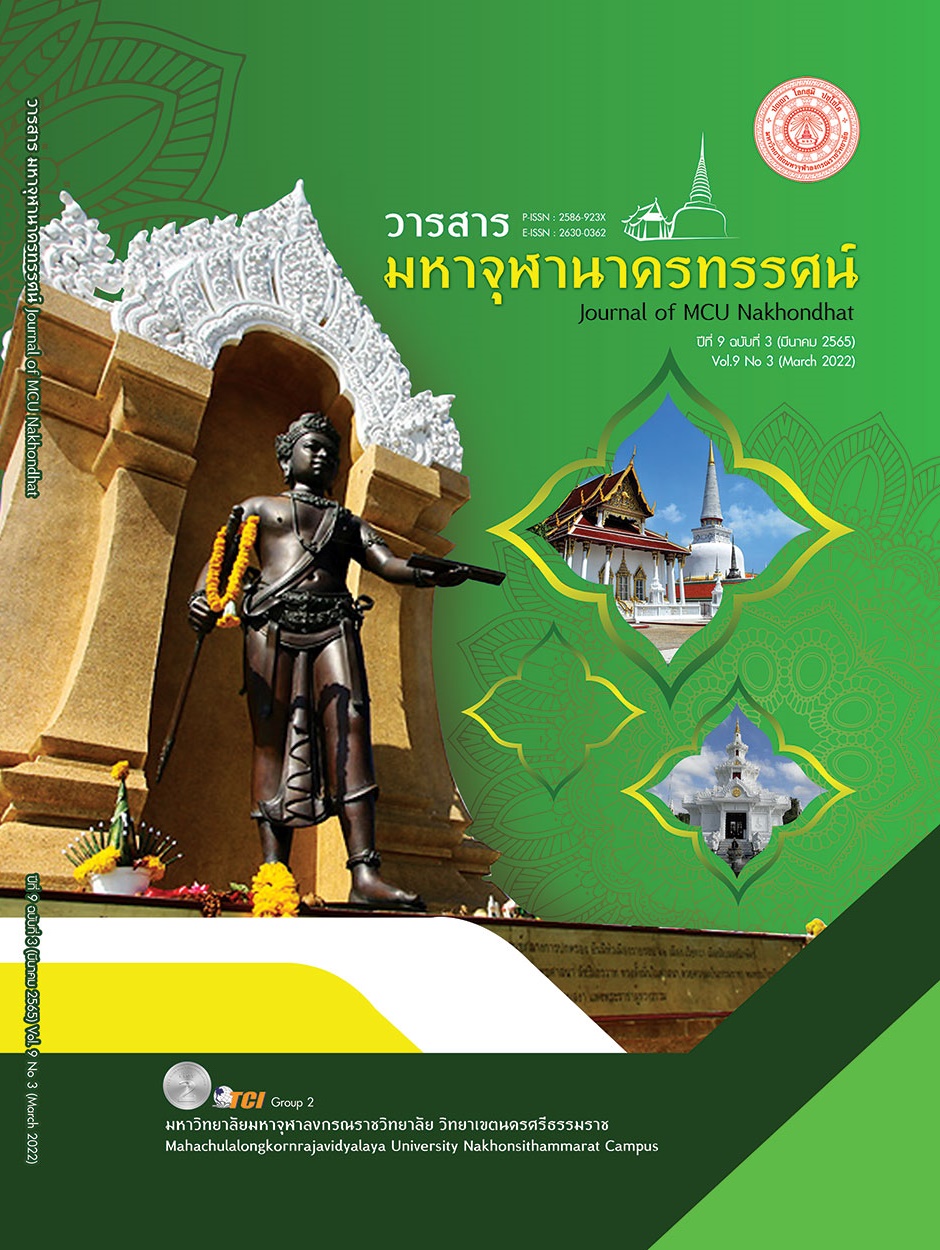A DEVELOPMENT OF ACADEMIC ACHIEVEMENT AND CREATIVITY IN PHYSICS OF GRADE 10 STUDENTS, IN THE TOPIC OF SHOCKPROOF PACKAGING BOX, THROUGH INQUIRY-BASED STEM LEARNING
Main Article Content
Abstract
This research article aims to develop academic achievement and develop creativity of secondary school students in physics, which a Quasi Experimental Design. By using STEM education activity, in the Topic of Shockproof Packaging Box. The target groups in the research were 30 students in Grade 10 special classrooms for science, mathematics, technology and the environment in the academic year 2020 by specific selection. The tools used include 1) STEM EDUCATION ACTIVITIES GUIDE Shock-proof packaging box. 2) An achievement test in physics subject on Momentum, inhalation and Impulse It is a 20-item, 4-choice test used to measure before and after the activity.3) Creativity Assessment The four areas of creativity are originality, fluency, flexibility, and elaboration. The statistics used to analyze the data were mean, standard deviation, and t-test. The results showed that 1) Educational achievement of Grade10 students in physics subject on Momentum, inhalation and Impulse by using learning activities according to STEM education approach. The mean score before studying was 12.93 points, representing 64.65%, and the mean score after school was 18.43 points, representing 92.15 on the mean difference test. It was found that the average score after school was statistically significantly higher at the .05 level . 2) Students who have learned using STEM-based learning activities Shock-proof packaging box Able to develop creativity in all 4 areas with average In descending order as follows, flexibility was 3.80, originality was 3.50, elaboration was 3.16, and fluency was 3.00.
Article Details

This work is licensed under a Creative Commons Attribution-NonCommercial-NoDerivatives 4.0 International License.
References
กรวิทย์ เกื้อคลัง. (2561). ผลสัมฤทธิ์ทางการเรียนโดยการจัดการเรียนรู้ตามแนวทางสะเต็มศึกษา เรื่อง สภาพสมดุล และสภาพยืดหยุ่น ของนักเรียนชั้นมัธยมศึกษาปีที่. วารสารศึกษาศาสตร์ มหาวิทยาลัยทักษิณ, 18 (2), 124-135.
นัสรินทร์ บือซา. (2558). ผลการจัดการเรียนรู้ตามแนวคิดสะเต็มศึกษา (STEM Education) ที่มีต่อผลสัมฤทธิ์ทางการเรียนชีววิทยา ความสามารถในการแก้ปัญหาและความพึงพอใจต่อการจัด การเรียนรู้ของนักเรียนชั้นมัธยมศึกษาปีที่ 5. ใน วิทยานิพนธ์ศึกษาศาสตรมหาบัณฑิต สาขาวิชาการสอนวิทยาศาสตร์และคณิตศาสตร์ มหาวิทยาลัยสงขลานครินทร์. มหาวิทยาลัยสงขลานครินทร์.
พลศักดิ์ แสงพรมศรี. (2558). การเปรียบเทียบผลสัมฤทธิ์ทางการเรียนทักษะกระบวนการทางวิทยาศาสตร์ขั้นบูรณาการและเจตคติต่อการเรียนเคมีของนักเรียนชั้นมัธยมศึกษาปึที่ 5 ที่ได้รับการจัดการเรียนรู้สะเต็มศึกษากับปกติ. ใน วิทยานิพนธ์การศึกษาศาสตรมหาบัณฑิต สาขาเคมีศึกษา. มหาวิทยาลัยมหาสารคาม.
เพชรรัตน์ พูลเพิ่ม. (2563). การศึกษาผลการเรียนรู้กลุ่มสาระวิทยาศาสตร์ เรื่อง ลม ฟ้า อากาศ ของนักเรียนชั้น ประถมศึกษาปีที่ 5 โดยใช้การจัดการเรียนรู้แบบสะเต็มศึกษา (STEM). ใน วิทยานิพนธ์ศึกษาศาสตรมหาบัณฑิต สาขาวิชาหลักสูตรและการสอน. มหาวิทยาลัยราชธานี.
ภัสสร ติดมา. (2558). การจัดการเรียนรู้ตามแนวทางSTEM Education เรื่องระบบของร่างกายมนุษย์ เพื่อส่งเสริมความคิดสร้างสรรค์ สำหรับนักเรียนชั้นมัธยมศึกษาปีที่ 2. วารสารราชพฤกษ์, 13 (3), 71-76.
วชิร ศรีคุ้ม. (2559). การจัดการเรียนรู้ตามแนวทางสะเต็มศึกษา. เรียกใช้เมื่อ 1 ตุลาคม 2562 จาก https://www.slideshare.net/wawachira/stem-education-62525207
ศิวณัฐ ภูมิโคกรักษ์. (2562). การศึกษาผลการเรียนรู้คณิตศาสตร์และความคิดสร้างสรรค์ของนักเรียนชั้นมัธยมศึกษาปีที่ 3 โดยการจัดการเรียนรู้ตามแนวคิดสะเต็มศึกษา. วารสารราชพฤกษ์, 17 (2), 73-79.
สนธิ พลชัยยา. (2557). สะเต็มศึกษากับการคิดขั้นสูง. นิตยสาร สสวท, 42 (189), 7-8.
สิรินภา กิจเกื้อกูล. (2558). สะเต็มศึกษา. วารสารศึกษาศาสตร์ มหาวิทยาลัยนเรศวร, 17 (2), 201-207.
Han, S. et al. (2014). How Science, Technology, Engineering and Mathematics (STEM) Project-based Learning (PBL) affects High, Middle and Low Achievers Differently: The Impact of Student Factors on Achievement. International Journal of Science and Mathematics Education, 13 (5). 1089-1113.
Laura, G. (2012). Assessing 21st Century Skills : A Guide to Evaluating Mastery and Authentic Learning. California: Corwin Press, Inc.
Torrance E.P. (1965). Rewarding creative behaviour : experiments in classroom creativity . Englewood cliffs, New Jersey: Prentice Hall.


